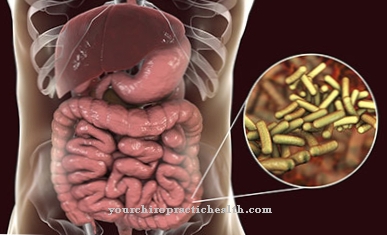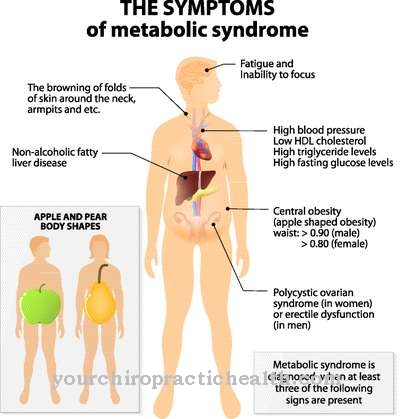Does the doctor speak of one Urea cycle defect, he uses an attack that primarily affects several metabolic diseases that have a genetic origin on the one hand and are responsible for impaired nitrogen excretion on the other. If left untreated, the urea cycle defect leads to patient death. Liver transplantation is the only form of therapy to correct the urea cycle defect.
What is a urea cycle defect?

© thepoo - stock.adobe.com
A urea cycle defect usually serves as an umbrella term for several metabolic diseases, all of which have impaired nitrogen excretion. Another common feature is the genetic origin; such metabolic diseases can therefore be inherited.
Since a urea cycle defect leads to a pathological increase in the nerve toxin ammonia, the disease - if not treated in time - leads to brain damage and subsequent death. It should be noted that there are six different enzyme defects. Symptoms can vary, depending on age and initial manifestation.
causes
Urea cycle defects are inherited as an autosomal recessive trait. The only exception is the OTC shortage; the OTC deficiency is inherited exclusively in an X-linked recessive manner. Sometimes spontaneous mutations can also occur. This means that the urea cycle defect is not inherited, but rather the genetic defect arose spontaneously.
Urea cycle defects are therefore congenital metabolic diseases of the liver that are potentially life-threatening. This not only leads to an increase in the ammonia level, but also to impaired protein breakdown. Due to a deficiency in certain enzymes, the body is unable to subsequently convert ammonia, a toxic intermediate product, into urea.
This inevitably leads to an increase in ammonia levels, with the nerve toxin being deposited in the blood and other tissues. There is a threat of brain and nerve damage; sometimes the disease can lead to death of the patient.
So far, six enzyme defects are known that are responsible for a urea cycle defect:
- Carbamyl phosphate synthetase (CPS) -1 deficiency
- Ornithine transcarbamylase (OTC) deficiency
- Argininosuccinate synthetase (ASA) deficiency (citrullinaemia type 1)
- Argininosuccinate Lyase (ASL) deficiency (arginine succinic acid disease)
- Arginase-1 deficiency (hyperargininemia)
- N-acetylglutamate synthetase (NAGS) deficiency
It has not yet been clarified why such deficiencies occur.
Symptoms, ailments & signs
Symptoms vary, depending on age and initial onset. They are therefore mainly based on the age of the person concerned. In infancy, vomiting, an extremely high breathing rate, seizures and reduced fluid intake are possible.Sometimes the baby can fall into a coma.
Seizures occur repeatedly in small children; Behavioral disorders, growth deficits and also reduced food and fluid intake could also be observed. Even in infancy there is a risk of the patient falling into a coma.
The following symptoms occur primarily in adolescents and adults: Those affected are irritable, lethargic, often confused, repeatedly suffer from nausea and vomiting and feel listless. In severe forms, patients can also fall into a coma. Depending on the clinical picture, the symptoms can vary. On the one hand, they can be particularly intense, but on the other hand, they can only occur slightly.
Diagnosis & course
Medical laboratory tests are carried out if there are symptoms that suggest a urea cycle defect. Doctors determine that the blood ammonia level is too high. The diagnosis can be substantiated, for example by a genetic test, whereby the identification of the mutation is checked here.
Serious disease courses result primarily from defects in the first three enzymes. Basically, the enzyme deficiency is subsequently responsible for the course of the disease that must be feared. Higher residual activities usually lead to chronic forms of the disease, whereby these only become noticeable after the neonatal phase.
If the urea cycle defect is treated incorrectly or not at all, it inevitably leads to brain and / or nerve damage. As a further consequence, an untreated urea cycle defect leads to the death of the person concerned. It does not matter which enzyme defect is present. All enzyme defects, if left untreated, can lead to death.
Complications
The urea cycle defect, if left untreated, leads to patient death in most cases. Because of this, urgent treatment of this disease is necessary for the patient. This also prevents complications and consequential damage. The affected person usually suffers from nausea and vomiting due to the urea cycle defect. There are also cramps that are associated with severe pain.
There is gasping and a panic attack is not uncommon. Likewise, the person concerned can lose consciousness or even fall into a coma. It is not uncommon for those affected to suffer from behavioral disorders, which can have a negative impact on development, especially in children. Patients tend to be confused and slightly aggressive. Sleep problems also lead to slight irritability.
If the defect is not treated, in most cases the patient's life expectancy is greatly reduced and ultimately death. The treatment itself does not lead to further complications. However, the affected person may need dialysis for a liver transplant. In most cases, the other symptoms depend on the underlying disease.
When should you go to the doctor?
Since the urea cycle defect can lead to death in the worst case, it must be treated by a doctor. Self-healing does not occur with this disease. The urea cycle defect can occur in children or infants. It leads to vomiting or a high breathing rate.
If the parents notice these symptoms, they should see a doctor. Complaints and irregularities in growth also indicate the disease. The disease also leads to seizures or difficulty drinking. Those affected suffer from behavioral disorders and are often aggressive or irritable.
Confusion also often points to the urea cycle defect. The severity of the symptoms can vary greatly, so that they do not always have to be a symptom of the defect. However, since the disease can only be cured by a liver transplant, an examination should always be carried out as a precaution if the symptoms mentioned are noticed.
Usually the urea cycle defect can be diagnosed by an internist. Treatment then takes place with the help of a surgical procedure in a hospital. It is not generally possible to predict whether the disease will progress positively.
Doctors & therapists in your area
Treatment & Therapy
Several therapies are available for treatment options. In the case of a neonatal disease manifestation that poses a risk to the life of the infant, intensive care treatment is initiated. Such treatments, which are also known as acute therapy, mainly take place in metabolic centers.
The goal of such therapies is to lower the toxic ammonia level. The ammonia level is lowered, for example, by dialysis, whereby the "blood wash" is only carried out when the ammonia concentration is above 400 µmol / l. The infants do not receive proteins; Sometimes drugs that are supposed to help reduce the ammonia blood level are also administered.
Liver cell therapy can sometimes be successful. Such therapies are recommended primarily for infants; Even if the liver transplant would be more effective, the procedure places extreme stress on the newborn that many doctors refrain from doing it. The risk that the child will not survive the procedure is too high in almost all cases.
In liver cell therapy, adult hepatocytes are obtained from the donor liver and then - free of bacteria - are cryopreserved in a suspension. In the long term, medical professionals choose diet and drug treatment. It should be noted that this treatment has to be carried out for a lifetime.
The only actually curative therapy that sometimes corrects the urea cycle defect is liver transplantation. The urea cycle defect can only be corrected if a liver transplant is carried out.
Outlook & forecast
In many cases, the diagnosis of urea cycle defect does not lead to normal life. The disease causes limitations in everyday life. Only long-term treatment can establish the greatest possible freedom from symptoms. Those affected have to expect restrictions in their diet when the hereditary disease occurs.
Blood washing and drug administration accompany life. A cure is impossible. If the defect is not recognized in time, brain damage usually occurs. Ultimately, the urea cycle defect then leads to death.
Statistically speaking, the disease occurs more frequently in certain phases of life. This is where the greatest risk prevails; However, the urea cycle defect is a marginal phenomenon in relation to all persons of a given age group. Boys and girls in infancy and childhood are particularly affected.
Around 50 percent of all diseases can be assigned to this age group, which corresponds to just 80 newborns per year in Germany. Occasionally women also get sick during pregnancy. In principle, cases of people of legal age are marginal.
Long-term therapy aims to keep the ammonia and glutamine concentrations in the blood within the normal range. This can be achieved by following a constant low-protein diet. If this procedure is followed, one can lead a symptom-free life. Patients need to show a high level of discipline for this.
prevention
Since a urea cycle defect is a genetic disease, the origin of which is unknown and which is usually passed on or is caused by a spontaneous mutation, the metabolic disease cannot be prevented.
Aftercare
Since a urea cycle defect cannot heal itself and the disease is a genetic disease, the options for follow-up care for this disease are in most cases severely limited. The person concerned is primarily dependent on a quick diagnosis with the subsequent treatment so that the symptoms do not worsen further.
In the worst case scenario, the patient can die if the disease is left untreated. Often the patients are dependent on the measures of dialysis. In doing so, they also need the care and support of their own family and friends. This can also alleviate or completely prevent psychological upsets or depression. When taking medication, patients should ensure that they are taken regularly and that the dosage is correct in order to alleviate the symptoms.
A healthy lifestyle with a balanced diet can also have a positive effect on the course of this disease. If the person concerned wishes to have children, genetic counseling is advisable in order to prevent the disease from recurring in the children. The patient's life expectancy may be reduced as a result of the disease.
You can do that yourself
A urea cycle defect is a serious illness that often takes a negative course. The most important self-help measure is to inform the responsible doctor immediately about unusual symptoms or to take the child to the nearest hospital. If a metabolic disease is actually present, treatment must be initiated immediately in order to avoid consequential damage.
The individual symptoms can be treated with the known means and measures. Dietary measures as well as bed rest and rest help against nausea and vomiting. Cramps can be relieved by calming down and using medical preparations. If the child shows signs of a panic attack or even passes out, the emergency doctor must be called.
In the case of behavioral disorders, behavior therapy, in which the parents should also participate, makes sense. Comprehensive training is an optimal way to react to irritability, aggressiveness and other abnormalities, which at least reduces the risk of developmental disorders.
In the long term, therapeutic advice is also useful. In many cases, the disease leads to the death of the patient - a circumstance that is an enormous burden for the affected child, but also for the relatives.

























.jpg)


